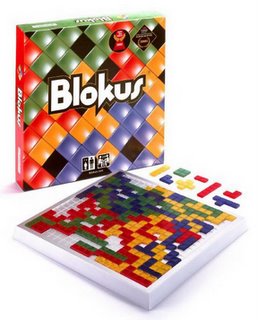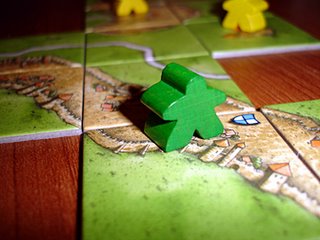
Welcome to The Game Table
by Ward Batty
As unlikely as it may seem, during the ascendancy of the videogame, the humble boardgame has been experiencing a renaissance of its own. This may not be immediately apparent at the big box stores that carry boardgames, where Monopoly and Trivial Pursuit still reign. But there are hundreds of boardgame titles in print and dozens of new ones released each year for the specialty game store and online markets. And some are even making their way into such stores as Toys 'R' Us.
These are called "designer games" because the game designer's name is featured, often prominently, on the box. Many of these games are co-published with European, mostly German, publishers. Several features distinguish these games: They are short, ranging from twenty to ninety minutes. Players are not generally eliminated from the game. There's also a sociability that is built into the games that increases the fun. Players compete against other players for victory points or to reach a goal. They rarely take directly from other players or send others backwards. There's lots of competition but much less conflict--which makes them a lot of fun to play.
With this column I will have the honor of introducing many of these great games to a larger audience as well as cover some of the latest news and notes from the world of board and card games. I'll start off with two recommendations.
Blokus, by Bernard Tavitian and published by Educational Insights, is easy to learn. It can be played at a high level of skill but is also fun for children as young as five. Blokus plays great for two to four players and is beautiful to look at. Players receive identical sets of pieces in their own color and with shapes that are familiar to any Tetris player. Pieces are laid starting in the player's corner and must touch their same-color pieces but only at the corners, no sides may touch. This rule applies only to each player's own pieces, so you can build next to opponents' pieces and squirt through at the corners. Not only is this a fun and challenging game that takes only about a half-hour, but also watching the board fill up into a colorful mosaic is also enjoyable.
 Carcassonne is a tile-laying game about building and populating the medieval city. The game begins with a single tile and through the course of the game tiles are added to create a complete game-board that is different every time. The turn is very simple, draw and play a tile. Any of four elements may be found on a tile. These are a green field, a road segment, a monastery or part of a walled city. Each player has seven "meeples" (miniature people) they place on a tile when they play it. The meeple is played on a specific element in that tile (on the road, for example) and scores when that element is completed. Players may not add a meeple directly to something that has a meeple. So one can't just add to someone else's road and hop on. Instead, one must build near what you want, then hope to draw a tile that makes the connection. Then both are in. Ties score equally for all players involved, so you want to get in on as many scoring opportunities as possible. But with only seven meeples to place, players must manage where they place so they can get some to score and become available to be placed again. The game generally takes about 45 minutes to play. Carcassonne scales great from two to five players and costs only about $20. Carcassonne is by Klaus-Jurgen Wrede and published by Rio Grande Games.
Carcassonne is a tile-laying game about building and populating the medieval city. The game begins with a single tile and through the course of the game tiles are added to create a complete game-board that is different every time. The turn is very simple, draw and play a tile. Any of four elements may be found on a tile. These are a green field, a road segment, a monastery or part of a walled city. Each player has seven "meeples" (miniature people) they place on a tile when they play it. The meeple is played on a specific element in that tile (on the road, for example) and scores when that element is completed. Players may not add a meeple directly to something that has a meeple. So one can't just add to someone else's road and hop on. Instead, one must build near what you want, then hope to draw a tile that makes the connection. Then both are in. Ties score equally for all players involved, so you want to get in on as many scoring opportunities as possible. But with only seven meeples to place, players must manage where they place so they can get some to score and become available to be placed again. The game generally takes about 45 minutes to play. Carcassonne scales great from two to five players and costs only about $20. Carcassonne is by Klaus-Jurgen Wrede and published by Rio Grande Games.To find these games locally, look for a specialty game shop. Even if they don't have the game in stock, they should be happy to order it. If you have a local store that carries the game, I'd suggest getting it there. With shipping the price won't be that much cheaper online and at the store you can look over some of the other great boardgames that are available and even get suggestions from the helpful folks there. Online, I'd suggest going to Google, click on Froogle and search for the game by name.
Photo credits. Blokus ©Educational Insights. Carcassonne ©Robert Hawkins. Used with permission.
Ward Batty is a long-time game-player who has been with the same weekly game group for over twenty years. "I understood there was a pension." is his excuse. He writes a monthly column on the business of board games for Comics & Game Retailer magazine and has written articles and reviews for The Games Journal, Scrye, Knucklebones and Games International.
The Game Table is a weekly column which is self-syndicated by the author. If you would like to see this column in your local newspaper, please write the managing editor of the paper. Interested in carrying The Game Table in your paper, please contact Ward Batty.
